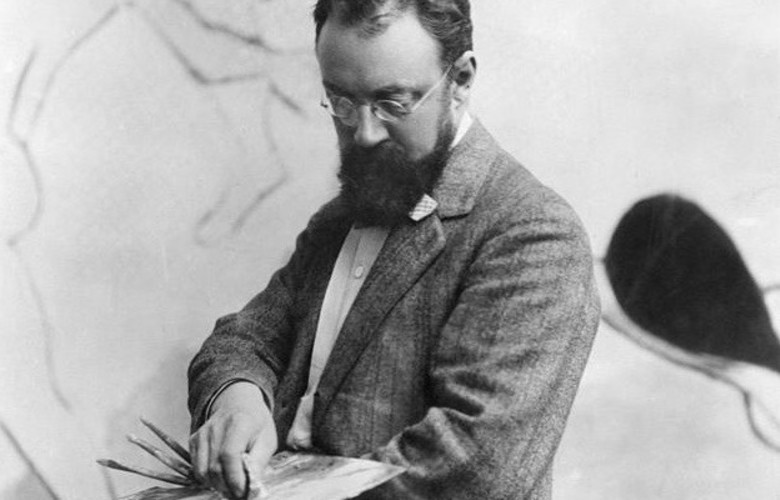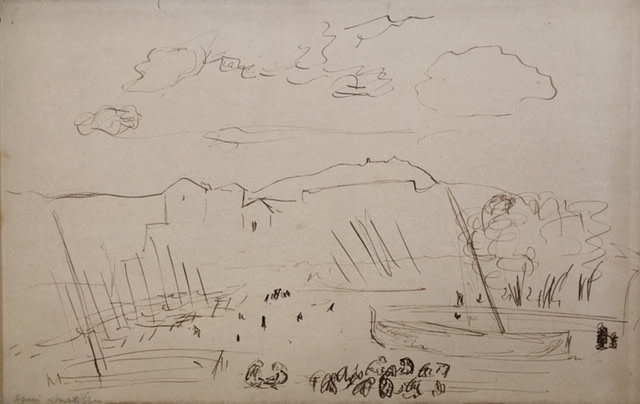
In 1905 Collioure, a small fishing town in the south west of France not far from the Spanish border, became the site of one of the most radical and significant reinventions of modern art. The paintings and drawings made that summer by Henri Matisse, working alongside André Derain in what John Russell described as 'ideal conditions' which 'were never to recur'1 established Matisse as the leader of the avant-garde in Paris at that time.

Le Port de Collioure
Matisse arrived in Collioure in mid-May and according to Hilary Spurling became 'the first painter to set foot in Collioure's single hotel'2, soon establishing himself there with his family and renting a studio overlooking one of the beaches. Later in the summer, following Derain's arrival, Matisse rented part of a house on the Plage Boramar; the present work was drawn from the end of the Plage Boramar looking back towards the 17th century Château Royal. While the motif recalls paintings of 1905 such as Derain's La Faubourg, Collioure (Musée National d'Art Moderne), it is more usual to see the view from the upstairs studio window. Drawn from the same level as the beach, here Matisse integrates elements of the surrounding landscape with the distinctive activities of the fishing community, still in 1905 with a substantial flotilla of more than a hundred boats bringing back anchovies and sardines.3
Behind the Château is the profile of the mountains that rise up behind the town. Fishing boats are lined up on the beach, their nets removed and the masts providing the drawing's central dynamic motif. In the foreground a group of figures sit leaning over, possibly mending nets or sorting through the catch. Hilary Spurling noted the significance of Matisse's drawing during that summer, and its direct relationship to the daily rhythm of the town.
The observation in Matisse's drawings and paintings is so accurate that a fisherman can tell the time of day, sometimes even the precise hour, when each was made...Matisse's Collioure sketchbooks record the daily round of a people who had lived and worked on the seashore since antiquity. He told his son-in-law long afterwards that these ancient patterns gave him energy for the Dance, the huge frieze of leaping scarlet figures on a flat blue and green ground that outraged the Paris art world in 1910.4

Henri Matisse, Le Port de Collioure, 1905, ink (The Court Gallery)
While the extraordinary use of colour is the defining aspect of Matisse's Collioure paintings from 1905 and caused the greatest shock when they were first exhibited, drawings such as Port de Collioure demonstrate a raw energy in Matisse's line that is central to their effect. The immediacy and directness of his notation reflects Matisse's excitement in his intuitive visual response to his surroundings.
Despite the speed at which he worked, however, there remained a strong compositional sense within these drawings. The masts leaning towards the sea are balanced by the right-leaning trunks of the trees at the end of the beach; the masts and figures moving towards the castle draw the eye towards the solid, rugged geometric shapes of the Chateau Royal and the mountain, while the light clouds that scud across the sky in that hot summer seem to echo the energy of the figures working on the beach. Hilary Spurling notes that Matisse found reassurance in Cezanne's words and example that summer and the connection of planes within the picture space of Port de Collioure demonstrates another aspects of his enduring importance for Matisse.
The intimacy of the drawing manages to convey Matisse's excitement at the liberation he discovered in Collioure, but it retains its own significance within this momentous summer of artistic revolution.
We are grateful to Dickon Hall for preparing this article.
Notes
1. John Russell, Matisse: Father and Son, Harry N. Abrams Inc., New York, 1999, p.22
2. Hilary Spurling, Matisse: The Life, Penguin, 2009, p.117
3. Véronique Richard de la Fuente, Guide de Matisse à Collioure, Éditions des Albarès, Cret, 2004, p.16
4. Spurling, p.118
